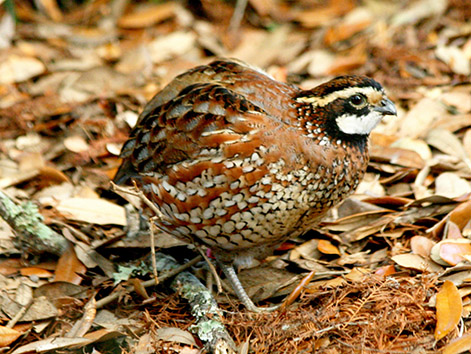The Effects of Landscape Configuration on Northern Bobwhite in Southeastern Kansas
 Investigator:
Investigator:
Brian E. Flock, Ph.D. Student
Project Supervisor:
Dr. Philip S. Gipson
Funding:
Kansas Department of Wildlife, Parks,
and Tourism
Location:
Southeastern Kansas
Completion:
2006
Status:
Completed
Objectives:
Study the responses of Northern bobwhite to landscape scale habitat improvements.
Results:
Northern bobwhite (Colinus virginianus) populations in much of the species range have been declining for the last 35 years. I trapped and equipped bobwhite with radio transmitters and tracked them during 2003-2005. I used these data to examine the effects of landscape configuration on survival as well as the habitat association of bobwhite in southeastern Kansas. I used the nest survival model in Program MARK to determine the effects of habitat configuration on weekly survival of radio equipped bobwhite during the Fall-Spring (1 October to 14 April) and the Spring-Fall (15 April to 30 September) at home range and 500 m buffer scales. Individual survival probability for the Fall-Spring period was 0.9439 (S.E. = 0.0071), and the most parsimonious model for the Fall-Spring period at the home range scale was B0 + percent woodland + percent cropland. At the 500 m buffer scale the most parsimonious model was B0 + percent Conservation Reserve (CRP) program land. The weekly survival probability for the Spring-Fall period was 0.9559 (S.E. = 0.0098). At the home range and 500 m buffer scales there were weak associations of habitat to survival during Spring-Fall with the most parsimonious model for both scales B0 + percent other. Using Euclidean Distances to measure distance from animal location to each habitat, I found that habitat selection was occurring during the Spring-Fall (Wilkes λ = 0.04, F 6,36 = 143.682, P < 0.001) and Fall-Spring (Wilkes λ = 0.056, F 6, 29 = 81.99, P < 0.001). During Spring-Fall bobwhite were associated with locations near cool-season grasses and during Fall-Spring preferred locations near woody cover. Bobwhite also showed habitat selection at a second more refined land use classification level for Spring-Fall (Wilkes λ = 0.006, F 16, 26 = 284.483, P < 0.001) and Fall-Spring (Wilkes λ = 0.004, F 16, 19 = 276.037, P < 0.001). During the Spring-Fall, bobwhites were associated with locations near cool-season grass pastures and roads and during Fall-Spring were associated with locations in close proximity to roads and CRP. Understanding the effects of habitat configuration on bobwhite is an important step in developing a broad-scale management plan.
Products:
Peer-reviewed Publications:
Flock, B. E., Gipson, P. S., Applegate, R. D., & Ballard, W. B. 2012. Distance-based habitat associations of northern bobwhites in a fescue-dominated landscape in Kansas. In Proceedings of the National Quail Symposium (Vol. 7, pp. 42-51).
Dissertation:
Flock, B.E. 2006. The effects of landscape configuration on northern bobwhite in southeastern Kansas . Ph.D. Dissertation. Division of Biology, Kansas State University. (Advisor: Gipson)